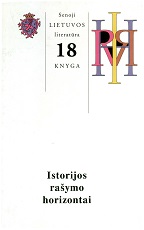Vėlyvųjų Lietuvos metraščių veikėjai ir jų prototipai: „Romėnai“
The personages of the Lithuanian chronicles and their prototypes: The „Romans”
Author(s): Kęstutis GudmantasSubject(s): Literary Texts
Published by: Lietuvių literatūros ir tautosakos institutas
Keywords: the so-called theory of Roman origin of the Lithuanian nobility;
Summary/Abstract: The article deals with so-called theory of Roman origin of the Lithuanian nobility. According to 16th century Lithuanian chronicles, prince Polemon left Italy with 500 Roman nobles (among them – leading Centaurus, Columna, Ursini and Rose families) trying to escape from the persecutions of Nero. The refugees landed territory of nowadays Lithuania, named the country, established the state – The Grand Duchy of Lithuania etc. etc. They also started 3 ruling dynasties. The first thing to be mentioned is that here we have a popular Colonna and Orsini topos which has a purpose to assert Roman origin of the Lithuanian nobility and also using of Italian heraldry has the task to legitimate Roman origin of the Lithuanian couts of arms. More informative is the second version of the Lithuanian chronicles (Raczynski and other ms.). Here the representatives of 4 leading families are mentioned by name: Dovsprung represents Centaurus, Prosper Columna, Hector Rose and Julianus Ursini family. Here we have the direct allusion to the great voyage of Italians to Poland in 1518. This year princess of Bari Bona Sforza became a queen of Poland and grand duchess of Lithuania. The chief protector of princess in her trip was her relative famous warrior duke Prospero Colonna (or Columna). But the things are even more complicated, because according to the chronicles the Jagiellonian kings and grand dukes (14–16th centuries) are from Columna family and even prominent Lithuanian nobles Goštautai are from it. So the wedding ceremony, which took place in year 1518 was the alliance of “Romans”. The immense heightening of Goštautai can be explained by the fact that the chronicles were created on the initiative of Albertas Goštautas, powerful chancellor of the GDL (1522–1539). It is possible, that “the alliance of ‘Romans’” was not an original idea, because of the similar plot in the Epithalamium written by Laurentius Corvinus Silesius. There also are few suggestions on the chronology of these historical writings.
Journal: Senoji Lietuvos literatūra
- Issue Year: 2004
- Issue No: XVIII
- Page Range: 113-139
- Page Count: 27
- Language: Lithuanian

